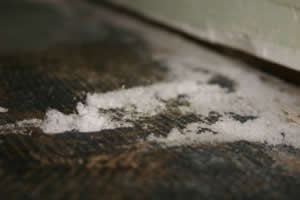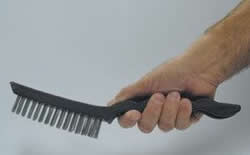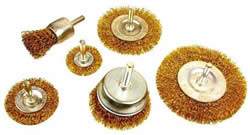Efflorescence is a white powder that usually found on below ground foundation floors, as shown in Figure 1, walls, footings, framing that rests on a foundation wall. Efflorescence is not mold or mildew. Efflorescence is caused by the natural evaporation of water that contained mineral salts. The white powder is the residue left over when the water has evaporated.

Figure 1 - Efflorescence on basement floor
Efflorescence is generally nondestructive. However it can be unsightly and in a few circumstances will cause flaking of the outer surface of the concrete or bricks that it is resting on.
How To Remove Efflorescence:
Fresh Efflorescence:
Efflorescence that has recently appeared can usually be removed in the following manner.
- Use a wire brush, as shown in Figure 2, or a wire brush attachment for an electric drill, as shown in Figure 3 and remove as much of the efflorescence as possible.

Figure 2 - Wire brush

Figure 3 - Wire brush attachment for an electric drill
- Sweep-up the efflorescence removed by the wire brushes.
- Make a 1 to 4 solution of vinegar and water (1 part vinegar to 4 parts water) and apply it to the efflorescence affected area using a nylon brush.
- Allow the vinegar/water solution to sit on the surface of the affected area for 15 minutes, but do not allow the solution to dry.
- Rinse the area with clean water.
Note: Always use safety glasses when using a wire brush or electric drill wire brush attachment.
Note: Efflorescence is highly abrasive. I do not recommend using the house vacuum cleaner. If you want to vacuum up the efflorescence that you removed with the wire brushes, use an industrial vacuum.
Note: Multiple applications of the water/vinegar solution may be required.
Old Efflorescence:
Efflorescence that has been apparent for a number of years can usually be removed in the following manner.
- Use a wire brush, as shown in Figure 2, or a wire brush attachment for a power drill, as shown in Figure 3 and remove as much of the efflorescence as possible.
- Sweep-up the efflorescence removed by the wire brushes.
- Make a 1 to 9 solution of muriatic acid and water (1 part muriatic acid to 9 parts water) and apply it to the efflorescence affected area using a nylon brush.
- Allow the muriatic acid/water solution to sit on the surface of the affected area for 15 minutes, but do not allow the solution to dry.
- Rinse the area with clean water.
Note: Always use safety glasses when using a wire brush or electric drill wire brush attachment.
Note: Efflorescence is highly abrasive. I do not recommend using the house vacuum cleaner. If you want to vacuum up the efflorescence that you removed with the wire brushes, use an industrial vacuum.
Warning: Always add the muriatic acid to the water. Do not add the water to the muriatic acid!
Note: Muriatic acid is highly corrosive and the fumes can be toxic. Always work in areas that are well ventilated and wear the appropriate safety devices; safety goggles and rubber gloves, as well as protective clothing.
Muriatic acid can be purchased online or at most of the big box home improvement centers and swimming pool chemical retailers.
Note: Multiple applications of the water/vinegar solution may be required.
Efflorescence usually stops forming after the mortar or concrete completely dried out, a couple of years. However in certain instances, high alkaline soils, the efflorescence is more persistent and will come back repeatedly.
To stop persistent efflorescence:
- Clean the efflorescence using one of the methods previously described.
- Use a power washer to clean the affected areas.
- Seal the affected areas with a high quality silicone concrete and masonry sealer.
Note: You may have to apply the silicone concrete and masonry sealer once a year to prevent the efflorescence from returning.
